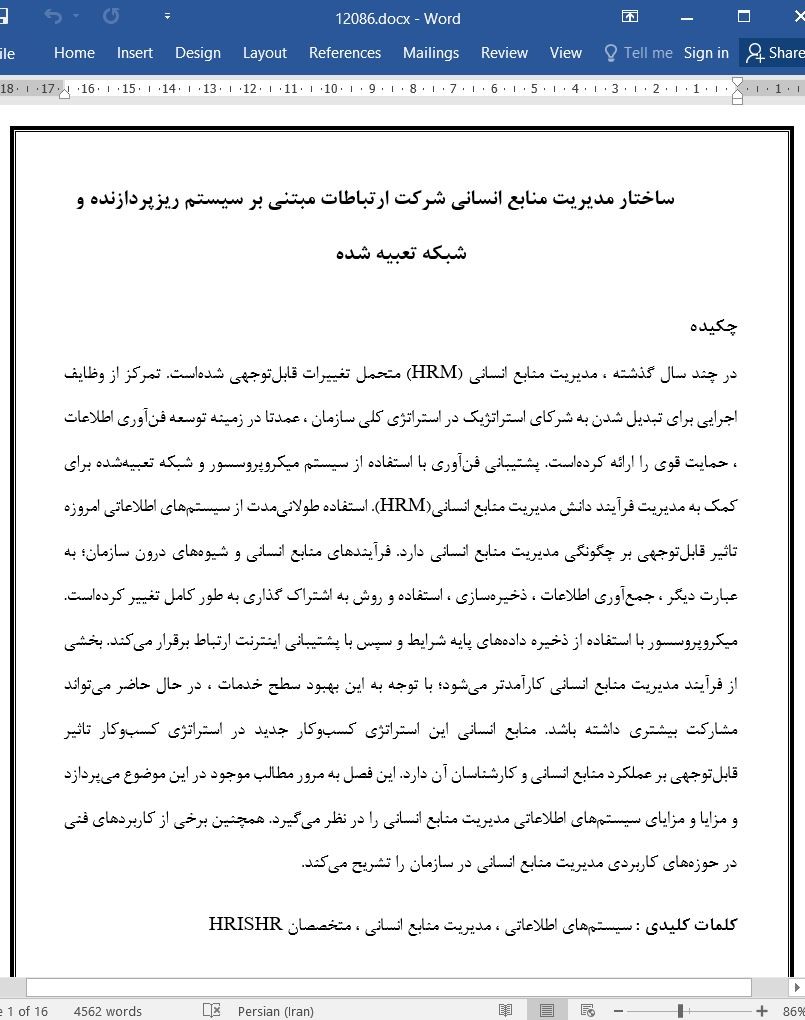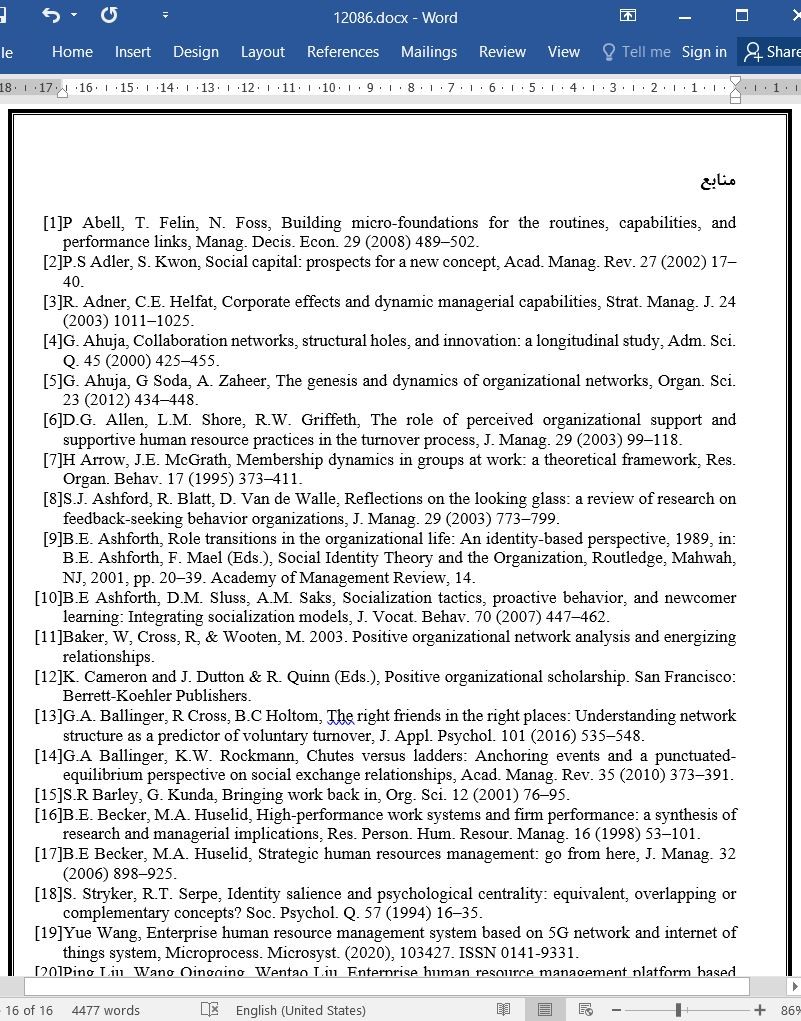
ساختار مدیریت منابع انسانی شرکت ارتباطات مبتنی بر سیستم ریزپردازنده و شبکه تعبیه شده
چکیده
در چند سال گذشته ، مدیریت منابع انسانی (HRM) متحمل تغییرات قابلتوجهی شدهاست. تمرکز از وظایف اجرایی برای تبدیل شدن به شرکای استراتژیک در استراتژی کلی سازمان ، عمدتا در زمینه توسعه فنآوری اطلاعات ، حمایت قوی را ارائه کردهاست. پشتیبانی فنآوری با استفاده از سیستم میکروپروسسور و شبکه تعبیهشده برای کمک به مدیریت فرآیند دانش مدیریت منابع انسانی(HRM). استفاده طولانیمدت از سیستمهای اطلاعاتی امروزه تاثیر قابلتوجهی بر چگونگی مدیریت منابع انسانی دارد. فرآیندهای منابع انسانی و شیوههای درون سازمان؛ به عبارت دیگر ، جمعآوری اطلاعات ، ذخیرهسازی ، استفاده و روش به اشتراک گذاری به طور کامل تغییر کردهاست. میکروپروسسور با استفاده از ذخیره دادههای پایه شرایط و سپس با پشتیبانی اینترنت ارتباط برقرار میکند. بخشی از فرآیند مدیریت منابع انسانی کارآمدتر میشود؛ با توجه به این بهبود سطح خدمات ، در حال حاضر میتواند مشارکت بیشتری داشته باشد. منابع انسانی این استراتژی کسبوکار جدید در استراتژی کسبوکار تاثیر قابلتوجهی بر عملکرد منابع انسانی و کارشناسان آن دارد. این فصل به مرور مطالب موجود در این موضوع میپردازد و مزایا و مزایای سیستمهای اطلاعاتی مدیریت منابع انسانی را در نظر میگیرد. همچنین برخی از کاربردهای فنی در حوزههای کاربردی مدیریت منابع انسانی در سازمان را تشریح میکند.
1 مقدمه
بازارها ، شرکتها و ادارات در حال تحول سریع نیازمند شرایط سلسله مراتبی هستند که مجهز به تنوع مداوم با افکار درخشان و پیشگامانه و کاهش شانس برای تبلیغات باشند. تحت این واقعیت جدی ، مدیریت منابع انسانی عملکرد اساسیتری نسبت به هر زمان دیگری در حافظه اخیر دارد زیرا انواع تجاری جدید نیاز به رویکردهای بهتری برای شامل کردن مردم دارند. کارشناسان منابع انسانی باید موقعیتهای اجتماعی ، پولی ، سیاسی-قانونی و مکانیکی آب و هوایی را برای ارتقا چرخههای مدیریت منابع انسانی و اعمال متغیرهای کلیدی موفقیت در ماموریت انجمن و مقاصد بررسی کنند.
6 جمعبندی
تاثیر تکنولوژی بر مدیریت منابع انسانی از اهمیت بیشتری برخوردار است. با توسعه فنآوری ، مدیریت منابع انسانی مجبور به ترسیم یک پروفایل جدید در فرآیند و عمل میشود. به نظر میرسد که سیستم اطلاعات منابع انسانی این تغییر را بسیار ثمربخش میکند. این برای بهبود دقت ، دسترسی سریع به اطلاعات ، افزایش رقابت و کارایی و ظرفیت منابع انسانی طراحی مجدد است. هدف واقعی پاسخ آن به سیستم اطلاعات منابع انسانی در تقاضای واقعی هنوز مشکلات زیادی در مدیریت منابع انسانی وجود دارد. اگر چه استفاده از آن و نتایج وجود محدودیتهای خاص اما نقش آن در مدیریت منابع انسانی میتواند به سرعت به تقاضا و تغییرات مدیریت منابع انسانی پاسخ دهد. ارزیابی ، بازخورد ، برنامهریزی منابع انسانی ، برنامهریزی جانشین پروری ، مهارتهای نظارت ، تجزیه و تحلیل نیازهای آموزشی ، تجزیه و تحلیل جهانی. سیستم اطلاعات منابع انسانی یکی از بزرگترین متحدان مدیریت منابع انسانی است که برای کارآمدتر و دقیقتر کردن سازمان اتخاذ شدهاست.
Abstract
In the past few years, human resource management (HRM) has undergone significant changes. The focus from administrative tasks to become strategic partners into the organization's overall strategy, mainly in the field of development of information technology, has given strong support. The technology support using Microprocessor System and Embedded Network to help handle the HRM knowledge process. Long-term use of information systems today have a significant impact on how to manage HRM. The Human Resources (HR) processes and practices within the organization; in other words, the collection of information, storage, use, and sharing method have changed completely. The Microprocessor System using to store the condition base data and then communicate with internet support. Part of the HRM process becomes more efficient; due to these improved service levels, it can now be more participation. Human resources of this new business strategy in business strategy have a significant impact on the human resources function and its experts. This chapter reviews the existing literature on this topic and considers the advantages and benefits of HRM information systems. It also outlines some of the technical applications in the functional areas of HRM in the organization.
1. Introduction
Quick evolving markets, ventures, and administrations require hierarchical conditions equipped for steady variation with brilliant, groundbreaking thoughts and diminished chance to-advertise. Under this serious reality, HRM has a more basic function than any time in recent memory because new business types require better approaches for including people.HR experts must examine social, monetary, political-lawful, and mechanical climate occasions to upgrade HRM cycles and practices key achievement variables to the association mission and destinations.
6. Conclusions
The impact of technology on HRM is more important. With the development of technology, HRM is forced to draw a new profile in the process and practice. HRIS appears to make this change most fruitfully. This is to improve the accuracy, quick access to information, increase competitiveness and efficiency, and human resource capacity of the redesign. The real purpose of its response to the HRIS on actual demand, there are still many problems. Human Resource Management. Although its use and the results of the existence of certain limitations, but its role in human resource management, it can respond more quickly to demand and human resource management changes. Assessment, feedback, human resource planning, succession planning, monitoring skills, training needs analysis, global analysis. HRIS is one of the biggest allies of HRM, has been adopted to make the organization more efficient and accurate.
چکیده
1 مقدمه
2 نقش استراتژی در منابع انسانی
2-1 برنامهریزی و پیشبینی به عنوان یک عملکرد حیاتی از مدیریت منابع انسانی
2-2 مدیریت استعداد
3 کارهای مرتبط
4 روش پیشنهادی
4-1 سیستم تعبیهشده
4-2 ساختار یک سیستم تعبیهشده
4-3 پردازشگرهای یک سیستم
4-4 سیستم مدیریت منابع انسانی
5 نتیجه و بحث
6 جمعبندی
اظهار منافع رقابتی
تقدیرات
منابع
Abstract
1. Introduction
2. The role of strategy in human resource
2.1. Planning and forecasting as a critical function of HRM
2.2. Talent management
3. Related works
4. Proposed methodology
4.1. Embedded system
4.2. Structure of an embedded system
4.3. Processors in a system
4.4. HRM system
5. Result and discussion
6. Conclusions
Declaration of Competing Interest
Acknowledgements
References
- اصل مقاله انگلیسی با فرمت ورد (word) با قابلیت ویرایش
- ترجمه فارسی مقاله با فرمت ورد (word) با قابلیت ویرایش، بدون آرم سایت ای ترجمه
- ترجمه فارسی مقاله با فرمت pdf، بدون آرم سایت ای ترجمه



